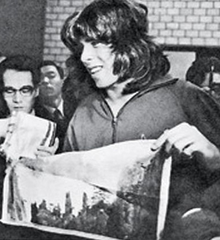| Glenn Cowan | |
|---|---|
 Glenn Cowan receiving a silk print from Zhuang Zedong, 1971 Glenn Cowan receiving a silk print from Zhuang Zedong, 1971 | |
| Personal information | |
| Nationality | American |
| Residence | Culver City, California |
| Born | (1952-08-25)25 August 1952 New Rochelle, New York |
| Died | 6 April 2004(2004-04-06) (aged 51) Los Angeles County, California |
Glenn L. Cowan (August 25, 1952 – April 6, 2004) was an American table tennis player.
Biography
Cowan was from New Rochelle, New York, and was Jewish. His parents were Phil (a television executive, who died at age 48) and Fran Cowan. The family later moved to Bel Air, California. He attended University High School.
In 1964, at age 12, Cowan won the singles for his age under-13s group in the Eastern regional junior championships. He won the 1967 U.S. Open junior under-17s table tennis championships. Two years later he won another U.S. Open.
One day during the 31st World Table Tennis Championship in Nagoya, Japan, American team member Cowan missed his own bus and in his haste got onto the bus of the Chinese team. Unlike his team mates, who ignored Cowan, Zhuang Zedong greeted him and presented him with a silk-screen portrait of the Huangshan Mountains, thus starting the so-called ping-pong diplomacy.
Cowan was arguably one of two critical personalities, the other being the Chinese table tennis player Zhuang Zedong, in the 1971 ping-pong diplomacy which helped paved the way for President Richard Nixon's visit to Beijing in 1972. He was the youngest player on the first U.S. table tennis team to compete in 1971's “Ping-pong diplomacy” tour to China.
Cowan studied at UCLA and Santa Monica College (1969 to 1972). He became a junior high school teacher. He was diagnosed, variously, as being bipolar and schizophrenic. He was married briefly. He lived in Culver City.
He died on April 6th 2004 at 51 years of age of complications during Heart Surgery.
Accolades
In 2008 he was inducted into the Southern California Jewish Sports Hall of Fame. He was posthumously inducted into the California Table Tennis Hall of Fame in 2014.
References
- Griffin, Nicholas. "How Mao Used Ping Pong to Woo Nixon". POLITICO Magazine.
- ^ Davis, David (August 1, 2006). "Broken Promise Los Angeles Magazine". Archived from the original on April 5, 2016. Retrieved August 2, 2020.
- ^ Wolff, Alexander. "Opening Volley". Sports Illustrated Vault.
- Staff, S. I. "FACES IN THE CROWD". Sports Illustrated Vault | SI.com. Archived from the original on 2021-10-21. Retrieved 2020-08-02.
- Ping-pong melts Cold War rifts Archived January 17, 2008, at the Wayback Machine
- 選手から大臣…隔離も『ピンポン外交』荘則棟氏. Tokyo Shimbun (in Japanese). July 8, 2008. Archived from the original on June 14, 2011. Retrieved October 10, 2010.
- "Southern California Jewish Sports Hall of Fame Home". scjewishsportshof.com. Archived from the original on 2020-06-05. Retrieved 2020-06-05.
- Andrews, Evan (19 October 2018). "How Ping-Pong Diplomacy Thawed the Cold War". HISTORY. Archived from the original on 2019-06-03. Retrieved 2020-06-05.
- "Santa Monica College Table Tennis Team Headed to National Championship"
- ^ "SMC Table Tennis Program Inducted Into California Hall of Fame". www.smc.edu. Archived from the original on 2016-09-26. Retrieved 2020-08-02.
- "Southern California Jewish Sports Hall of Fame Home". scjewishsportshof.com. Archived from the original on 2022-01-28. Retrieved 2020-08-01.
External links
- CNN: 'The ping heard round the world Revisited' Archived 2008-02-29 at the Wayback Machine
This biographical article relating to an American table tennis figure is a stub. You can help Misplaced Pages by expanding it. |
- American male table tennis players
- 1951 births
- 2004 deaths
- Sportspeople from Culver City, California
- Sportspeople from New Rochelle, New York
- Santa Monica College alumni
- University of California, Los Angeles alumni
- Jewish American sportspeople
- 20th-century American sportsmen
- North American table tennis biography stubs
- American sportspeople stubs